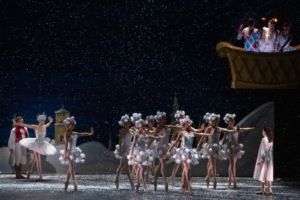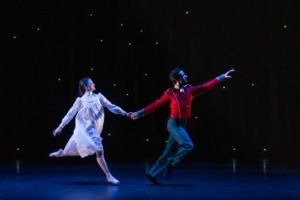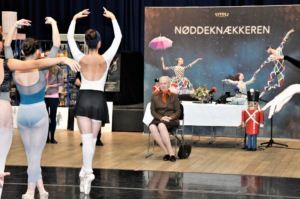Things to do
Performance Review: Nutcracker brings magic and glittering stars to Tivoli
This article is more than 7 years old.
★★★★★☆

Once again it didn’t disappoint (photo: Tivoli)
At this time of year, the adventures of Clara and her wooden nutcracker are danced all over the world. New versions are born every year. In Copenhagen, Tivoli intertwines tradition with creative artistry designed by HM Queen Margrethe II herself.
A Danish Nutcracker
The story is set in a 19th century Copenhagen lavish household. It’s Christmas Eve. Festivities are underway. Guests come bearing gifts. First major twist to the story: Tivoli’s guest-list. Among the prestigious guests are HC Andersen, August Bournonville, the Danish ballet master known for his egalitarian choreography and his ballet technique, and Bernhard Olsen, Tivoli’s artistic director from 1868 to 1885.
At the centre of it all, the Danish prolific writer cuts his ‘Papirklip’ while he speaks, unfolding a finished piece at the end of each tale – a glimpse at the author’s lesser-known talent: paper cuttings.
After a busy and jolly party, Clara sneaks downstairs to play with her nutcracker, and embarks on a magical adventure to defeat and behead the wicked Mouse King, flying through the Land of Snow to a magical dream country: Tivoli. Clara’s travel companions are none others than Pierrot, Harlequin and Columbine, the three famous characters of Tivoli’s summer Pantomime Theatre.
The archetype of the classical ballerina and her consort from Clara’s golden music box come to life to perform the dazzling grand pas de deux (extended duet), after an enchanting display of dancers from all over the world. It’s all rendered in the classic Bournonville style: with natural grace and no visible effort – the unique hallmark of Danish ballet.
Set and costumes designed by the queen
“Pen, pencils, paintbrushes … and my imagination” says the queen about her creative process. The Nutcracker is her 13th project as a scenographer since 1987, and this is the fourth performance of ‘The Nutcracker’ since its premiere in 2012.
The accomplished artist has created a rather traditional and delightful staging for the first act, along with an enchanted world using innovative fairy-tale material in the second act.
The first act is about celebrating Christmas in a Danish home. The red and white of the Dannebrog is the underlying theme chosen by the queen: from the Danish flags decorating the sumptuous Christmas tree to Fritz’ white pajamas and red scarf. As Clara’s adventurous dream unfolds, the Copenhagen skyline appears in a captivating snowstorm and breathtaking whirling snowflakes.
The second act unveils exotic colourful costumes, and Tivoli’s fantasy world with its well-dressed guards, first rollercoaster, Chinese-style Pantomime Theater, iconic main entrance and beautiful lighting.
In this unusual production, the children have become lanterns. “Knowing her notorious sense of humor, the Queen is most likely to be behind all those funny details” suggests Bente attending the premiere on Friday November 23. The queen sitting in the front row joins the dancers on stage, and curtseys like any other artist – twice!
The ballet for everyone
“A true classic, embracing adventure and magic for children and their families,” announces Peter Bo Bendixen, the former dancer, choreographer, and founder of Tivoli ballet school.
From the first flicker of the conductor’s baton, Tivoli Concert Hall is filled with Tchaikovsky’s most memorable melodies. A sublime score and one of the most instantly evocative works in the classical repertoire, it’s practically the soundtrack to Christmas.
Children aged 6 and up gasp at the tutus, the dancers, and the sets. It might be their very first experience of live ballet. The many child dancers who appear in this production could be inspirational to them and their pliés.
In most traditional adaptations of ‘The Nutcracker’, Clara is the protagonist with her prince in the first act and is usually relegated to the sidelines in the second act.
“The little ones who have invested in the young girl and her prince tend to lean forward enthralled as Act 1 unfolds, only to sink back in their seats as Act 2 gets under way. A challenge choreographers and directors have been tinkering with for more than a century,” explains Luke Jennings, a dance critic and author.
The amusement park’s Concert Hall offers its own take on Tchaikovsky’s classic ballet and spices it up thanks to its experience in pantomime theatre in the classical Italian commedia dell’arte tradition. The humorous miming designed for family entertainment keeps the younger audience’s interest. Tivoli succeeds in giving their heroes their romantic storyline back and in increasing six-year-olds’ attention span to circa 90 minutes.
Overall, it’s a unique and feel-good experience for the whole family lasting only 45 minutes per act with an intermission. An early finish. The Nutcracker at Tivoli is as quintessentially Christmassy as æbleskiver, julehjerter, risalamande and gløgg.
‘The Nutcracker’ runs until December 23, Tickets cost 250 kroner, which includes entrance to Tivoli. Find out more at tivoli.dk/juleballet and billetlugen.dk












































